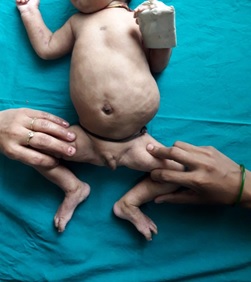Pramila Verma, Saurabh Kumar, Nitesh Upadhyay, Shweta Goyal, Minhajjudin Ahmad, Jaishree Ambhore
Department of Pediatrics, Chirayu Medical College, Bairagarh, Bhopal, Madhya Pradesh, India
Address for Correspondence: Dr Pramila Verma, Professor and Head, A–57 Dwarkadham colony, Airport Road, Bhopal, Madhya Pradesh, India.
Email: drpramilav@yahoo.com
|
Question :Two-month-old male baby presented with swelling of the abdomen. He was born of non-consanguineous marriage by normal vaginal delivery with an uneventful postnatal period. There was no history of steroid intake. On examination, he had pallor, microcephaly, doll like facies, distended and hypotonic abdomen with loose skin folds over the abdomen. Liver and spleen were not palpable. Other systems were normal. Ultrasound of abdomen and scrotum revealed bilateral hydroureteronephrosis, obstructive uropathy and undescended testis on right side. Laboratory report revealed serum urea 158.9 mg/dl and serum creatinine 1.36 mg/dl.
 What is the diagnosis?
|
Discussion :
Prune Belly Syndrome (PBS). It is characterized by the classical triad of urinary tract anomalies, deficient abdominal musculature and undescended testis. The impaired removal of urine from the bladder is responsible for oligohydramnios and pulmonary hypoplasia. The massive bladder distension and urinary ascites due to severe obstructive uropathy lead to degeneration of the abdominal wall musculature and failure of testicular descent. Associations of PBS with anomalies of musculoskeletal, cardiovascular, pulmonary and genital have also been reported. (1) The etiology of PBS is unclear and possible familial genetic inheritance was reported in some of the studies. PBS carries poor prognosis as the majority of infants are either stillborn or die within the first few weeks of life due to pulmonary hypoplasia or renal failure or a combination of congenital anomalies. PBS may survive into adult life if urinary tract repair and abdominal reconstruction surgery done during infancy. (2) In utero placement of a vesicouterine shunt is advisable to prevent the development of PBS. (3) | References : | - Manivel JC, Pettinato G, Reinberg Y, Gonzalez R, Burke B, Dehner LP. Prune belly syndrome: clinicopathologic study of 29 cases. Pediatr Pathol. 1989;9: 691– 711.
- Woodhouse CR. Prospects for fertility in patients born with genitourinary anomalies. J Urol. 2001 Jun;165(6 Pt 2):2354-60
- Leeners B, Sauer I, Schefels J, Cotarelo CL, Funk A. Prune-Belly syndrome: Therapeutic options including in utero placement of a Vesico amniotic shunt. J Clin Ultrasound. 2000;28:500–7.
|
|
| Correct Answers : |  43% 43% |
Last Shown : Dec 2017
|